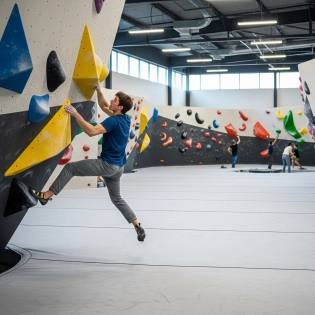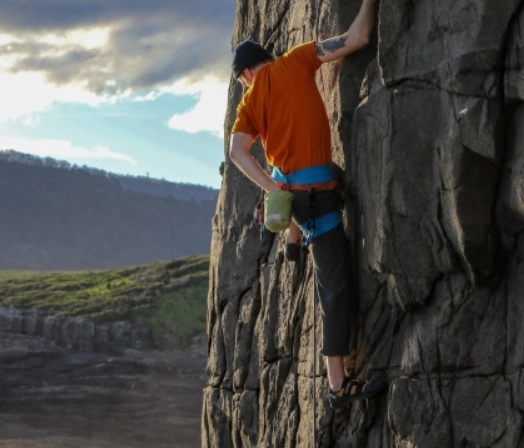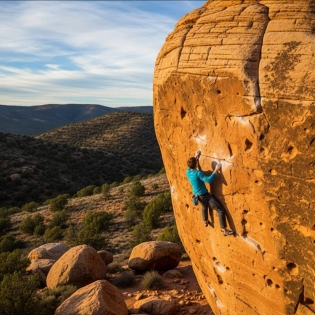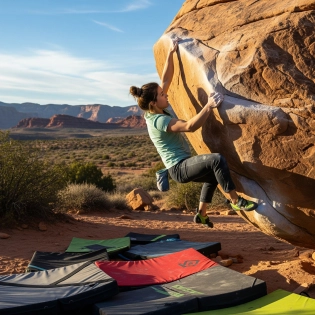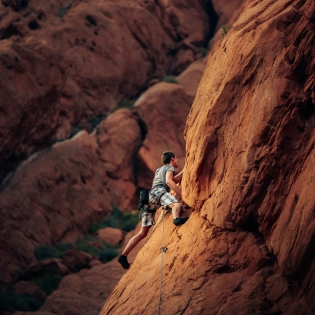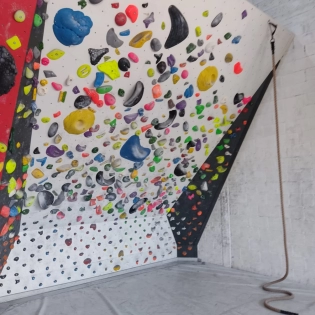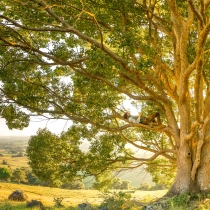

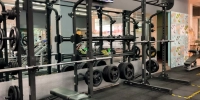
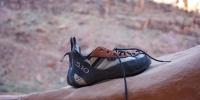




Climbers Point
Beginner here but I have been doing that for a few month, I don't know if it's ok or not though. I come from a weight lifting background, so to me it just comes natural to lift weight, it's the climbing part that is new for me, and in order to not be in the gym everyday I have been combining sessions. I haven't found what works best yet though as it's pretty random what I do first, either weight lift and then climb or climb and then weight lift.
I haven't gotten injured yet, but that might be because I have been physically active for years now. I would assume that if it's someone who has not been physically active and that climbing is the among the first and only physical activity they do, that they should be more cautious about weight lifting and climbing in the same day and take it slowly.
I just learned at the gym that this is actually an international way of encouraging or saying "you can do it". Pretty cool when the whole gym is yelling at you "alle" or "you can do it!".
I haven't gotten there yet, but I have come pretty close to doing one, but I think it was very much my "style" as it was a very physical boulder and I have been weight lifting for a few years and have some strength. I think I was just very much lacking the technique needed to actually do the boulder. If I would have done it though I don't know if I could have counted it as actually doing a real v6, since it might have been a very soft one and very much my style. I'm not sure that really counts.
I have taken a few breaks from climbing here and there, sometimes for a few months at a time, and each time my shoes felt more like plastic than I remembered. It's not to the point where it's a whole new break-in process, but, it usually takes about a session or two to get used to them again. It's really about getting my feet used to climbing shoes again, the shoes usually keep the shape they had before I took my break, it's my feet that need to re-adapt to the tightness of the shoes.
I have washed my chalk bag a few times throughout the years, not that it was REALLY needed, but, I personally like to refresh my gear after sometime. Other gear I might buy new, but chalk bags I feel can just live on until they are really in bad shape and ruined, especially because they are not a matter of safety. When it comes to safety or performance, like quick draws or shoes, I would buy new, but chalk bags don't fit those categories so I just keep them for as long as they last and give them a little wash if I want to "renew" them.
I've been climbing for a few years now and have never had to wash my chalk bag. What happened to yours? Did something spill on it? I can't imaging why one would need to be washed unless you are trying to sell it or it got into an accident and got spilled on!
Either way, I don't see why it would hurt to wash it by hand and let it dry out in the sun. I know that some chalk bags have different materials in them besides the fabric, so they may not all be good for the washing machine, but by hand I think is alright, but I have never had to do it before so I am not talking from experience!
I would add that it also depends on if it's indoor climbing or outdoor climbing. I don't climb indoors as much as I do outdoors, but usually when we go out we easily have full day sessions, leaving in the morning and getting back at night, sometimes the next morning even.
I doubt I would be able to have such long sessions in an indoor gym though. There is something about the outdoors that just makes it possible to have such long sessions. I think that for indoors my longest session has been about 3 hours.
Hope this helps!
As Joshua answered, you really dont need to downsize beginner shoes, because they are beginner shoes. Once you get past the beginner stage and get to the point where downsizing can actually contribute to your climbing, then its worth considering downsizing.
I wouldn't. Downsizing isn't really meant to be a beginner thing, it's really not beginner friendly. The whole point of downsizing is to have better control and performance for the more difficult and advanced routes, beginners don't climb on advance routes that require high performance shoes or downsizing.
I would hold off on downsizing and only do it when you get to the higher grades and are more knowledgeable in climbing and climbing shoes, it's a whole world out there!




Good cheer to all on this beautiful day!!!!!
Good luck :)

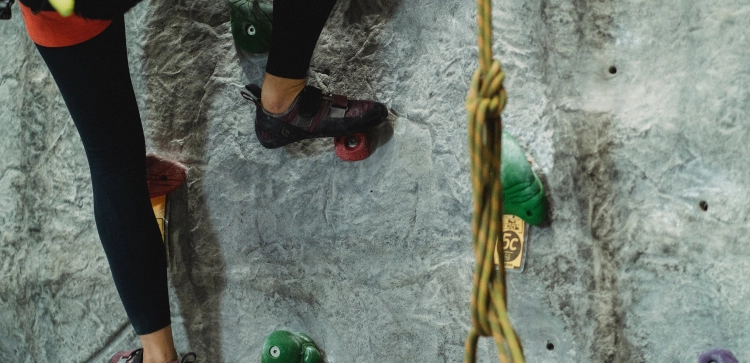


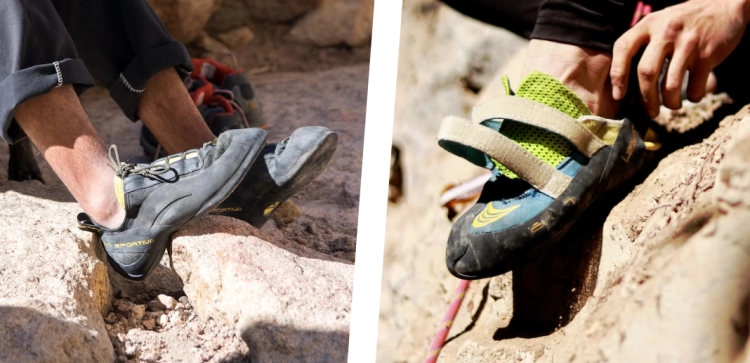
I don't have any lace climbing shoes, but so far I know quite a few people who have Velcro shoes that have torn and the Velcro strap is no longer attached. My shoes are actually very close to tearing it seems as well.
I have never seen anyone whose lace shoes have torn though, but I'm sure it happens, I just don't know at what rate compared to Velcro shoes.

There may be some brands that have similar sizing, most likely by chance, but overall brands can have very different sizing to their shoes. Even different shoes from the same brand tend to have different sizing.

I believe he said in one of his recent videos, or just in a video he was in, that he downsizes his shoes a few sizes less than he used to a few years ago. I can't remember the reason why he said he does it.

I would say you should always try them on and see what works for you. The same principles apply to choosing neutral climbing shoes as they do to choosing aggressive climbing shoes - try them on and feel what feels best for you.
I would keep in mind the intended usage of the shoes though, since if you are getting neutral shoes, you may be climbing longer routes such as in sport and trad climbing, in which case, downsizing to something very tight may feel very painful and uncomfortable due to wearing the shoes for so long.

For me the fit of climbing shoes has always been the same based on the shoes. I haven't changed my shoe size since I started climbing a few years ago, even when I try on shoes I already have, like the Evolv Shaman 2, I still find that the best fit is the same size I got when I first bought them a few years ago.
I don't really think there is a general best length. For me personally, I cut them just enough to not be too short, but don't leave enough to hear the nails on the wall. If they are even a little bit longer than that, they tend to sometimes get bent backwards while grabbing the holds, which obviously is not very pleasant.





























In my opinion, the problem is less about the actual hangboarding, and more about beginners not knowing when to stop and let their fingers rest. Since new climbers aren't usually used to the strain that climbing puts on their fingers and tendons, it's very easy to overtrain and to get injured.
This is true just by climbing alone. Add to that the element of hangboarding and you are in a very high risk of injury!
If a new climber can listen to their body, and also follow a strict program that will minimize the potential for finger injuries, even including hangboarding in the program could be fine. But, this will take a lot of self discipline that a lot of climbers don't seem to have.
Generally, I think that if you do things correctly, you could be fine doing finger specific training during your first year of climbing.



It for sure can if you wear the wrong shoes! It would also likely be a combination of other things such as wearing climbing shoes that are too small and landing badly, which could be bad regardless of the shoes, but wearing shoes that are not good for you would most likely increase the risk of bad landings.
Even without combining shoes and other factors, wearing climbing shoes that are not right for you, such as shoes that are too small, can cause damage by itself if you wear them for too long and if they are really too small.
Being well educated about how well sized climbing shoes should feel, mindful of if you got it wrong, and disciplined enough to listen to your body should help prevent damage to your feet though.
For me, after climbing for about a year, I noticed that my toes are more squished together, especially the tips of my toes. They have a sharper square shape rather than a round shape.
It sounds like either the shoes are not the right shape or fit, or there is a pressure point on your big toe. Or maybe you put too much weight on your big toe rather than spreading the weight across all of your toes?
Usually yes, but it should really be more of an uncomfortable feeling rather than actual pain. If you are used to climbing shoes, it may be fine, if not, you get used to it pretty quickly, assuming you didnt size down too much.
All of the boulders in my gym are actually around 2 grades below their given grade, I don't understand why they give them the higher grades and not the actual lower grades. Is there a reason for it?
I like training static and slow movements for climbing. I feel it translates the best to actual climbing.
I usually find a pull up bar and just do a lot of different grip width variations. Some narrow grip, some shoulder width, and some as wide as I can. All of them are done slowly and controlled, so I don't jerk myself up. I start from a complete dead hang position, slowly pull myself up, and even more slowly lower myself back down.
I also try to pull myself further up, so that I am in between a regular pull up and muscle up.
Training one arms is probably my favorite though, it also really requires very minimal gear, basically just a pull up bar.
Anything body weight and slow movement helps me, so pull ups, push ups, handstands, etc.
I put a vitamin E cream on my hands before I fall asleep. I feel it really helps after sessions that leave me with pulsating red fingertips with little to no skin. The one I use is from Jason, its a 25,000 IU cream, but there are also oils with 75,000 IU, I haven't tried that yet though.
Leaving the cream on overnight does help quite noticeably. It doesn't completely heal the skin after one night, but usually after a second night of doing this I can climb again the next day.
As long as you feel that they are the right fit for you, then yes. I remember when I bought my first real pair of climbing shoes after my beginner shoes, I tried downsizing as everyone had told me I have to, but even the salesman asked me to not downsize because the it just didn't fit me properly. What ended up being a "performance" fit for me was actually my street shoe size. This is in spite of everyone telling me I have to downsize to the smallest size that I can stick my feet in, regardless of the pain. So as long as you don't listen to that advice and you get what ever you can climb in without terrible pain, or without any pain at all, it should be fine.

Slightly, but not too much! Though, many climbers may say its just a matter of how comfortable you are with curled toes. If its not painful and it doesnt negatively impact performance, maybe its ok.
Honestly, getting the right size and just wearing them will really get the job done.
If your shoes are just not the right size though, then it maybe either not get better, or it may be a very long process. Not being the right size also includes shoes that are too big, so keep that in mind.
One thing I like to do is to bend then around and scrunch them up before putting them on. I do this for about a minute and it really helps soften then up and makes them much less painful.

There isnt a rule that says you need one, but, if you are going to use chalk then I would say yes, you do.
You could put your chalk in plastic containers like many new climbers do, but this is really not efficient, and its very easy for the chalk to spill and get knocked over.
Flexibility in my opinion is extremely underrated. I think being flexible can be one of the greatest tools in climbing.
I myself am not flexible at all, but my friends are, and the difference between how we climb is so noticeable. Moves that are so difficult for me are just easy to them.
You dont have to be flexible to climb, but, it would make a huge difference if you were.
It can equal stronger climbing, but not necessarily better climbing.
The problem with being very strong is that you start to neglect technique, because if you can just power yourself to the next hold or through the move, why would you do it in a more technical way? Even if you try to be more technical, it can be very hard to get rid of the habit of powering through moves. This is something many climbers struggle with, including myself.
On the other hand, if you are a technical climber, but are weak in terms of physical strength, training your forearms can help quite a lot by balancing you out a little bit. So you would still have the technique that you have developed until now, and you would also just be physically stronger.
So I would say that it just depends on your current situation. Are you more technical, or are you more powerful?
This is a very general question. Is it for bouldering? Sport climbing?
There is too much missing information in the question to be able to actually answer it accurately, but, in any case, it would most likely depend on your experience, technique, strength, and how determined you are.
I think its just a matter of preference. I personally order very cheap chalk blocks online and just break them up in my chalk bag.
Not so much that it will spill out, and not so little that you have to scrape the sides for it.
I tend to have 1-2 broken down chalk blocks in my chalk bucket. But this also depends on the size of your chalk bag.
What really helped me get better at sit starts was climbing on a moon board, and either finding boulders that have sit starts, or building new boulders with sit starts.
I was pretty bad at sit starts since they are very compressed for me, something I am fairly weak at. But after climbing for about a month almost only on the moon board, I really saw the improvement, and it was very noticeable.
I still work quite often on the moon board, and I can really see the difference from before and after. I try to do the most disgusting sit starts possible on the moon board, and I can do all of the sit starts on the regular route setting walls.
The moon board in my gym is a 30 degree angle I believe. If you don't have a moon board, I think you can probably do the same on any other system board.
Try to find the next best thing that you do have. Do you have a spray wall? If not, do you have an overhanging wall that you can make up boulders on using the existing holds?
Otherwise, I would just make up boulders anywhere in the gym and try to make them system-board-like.
There isn't really a "supposed to" or not when it comes to socks. You either prefer them or you don't.
Some wear them due to hygiene, some due to shoe sizing, and for some it's just comfortable.
Undoubtedly though, the majority of climbers do not wear socks with climbing shoes.
It can be pretty difficult and hard an you, but it really depends on how good you are at listening to your body and giving it the amount of rest it needs.
If you can do this well enough, climbing won't be that hard on you, it will just be hard in general, as a sport.
I sort of unlocked the v6's after 6 months actually. It was a pretty solid v6, and after that, it was as if this whole new world opened up and I was able to climb even more v6's. Of course not all, but some, and others I was able to do a few moves, while before I was struggling a lot on v5's.
Lead climbing multiple times a week, this is what helped me overcome my fear of heights, at least while climbing.
I found a friend to climb with, and we climbed 3 times a week. The frequent climbing amount really helped boost my confidence in being up so high, and my confidence in the gear and the knots and everything else.
Though, this didnt last long, as soon after we stopped lead climbing so often, my nervousness came back, and so did the fear eventually. Now I lead climb once in a while, and its hell for me. The fear just takes over once I get to a certain height.
Maybe if I would have climbed more during that time I climbed 3 times a week, meaning, doing it for months or a year, then maybe I would be more immune to the fear of heights, but, unfortunately it only lasted about a month or two. But during that time, towards the end, I was fearless.
How do you define a good body? Climbing can definitely make you stronger, but it wont necessarily change the way you look.
But then again, it depends on your definition of a good body.
If a stronger body counts as a good body alone, then yes, climbing can give you a good body.
Climbing most likely wont, for most people:
- Cause you to lose weight
- Put on a significant amount of muscle mass and size
Of course, climbing can motivate you to make these things happen, but climbing alone usually does not cause this.
Generally, no. Climbing shoes are supposed to be pretty tight.
I wear climbing shoes slightly bigger than my street shoe size, and I still cannot wiggle my toes.
I can slightly move them up and down a little, but not so much that I would consider it wiggling them.
This is a really general question. It depends on a few things:
-
Why kind of climbing are you referring to?
If its bouldering, then you can climb on your own, but if sport climbing, then you require one more person to belay you. -
Why are you climbing?
Assuming the reference is to bouldering, then the question is why you are climbing. If you are climbing to just detach your mind from the day and to just be physically active, then yea, you could climb alone, and it may be better also if you just don't want to deal with people.
On the other hand, if you are bouldering with the goal of improving, then I would say both options are important for your progress. Climbing with other people, especially those that climb better than you, can really give you more insight into climbing, more ideas, betas, experience, and just more growth in general. Climbing alone is still important in my opinion though because it's when you are alone that you can actually practice all that you have learned with others.
That's my take on climbing with people vs climbing alone.
Extra point:
I personally find it quite hard to have a proper bouldering session with some friends. Instead of climbing hard routes, we end up just messing around.
Rock climbing doesn't really get you big and bulky. It can make you stronger though, just without the massive body size.
There are some people who tend to grow and bulk up faster than others, at least to a certain size. They may get some more muscle mass than others, but for the most part, you muscle mass won't really increase that much.
Because we are in pain! But not that much pain. Generally, climbing shoes are not comfortable, and leaving them on for a long period of time just starts to hurt after a while. Taking them off in between some of the climbs just lets our feet relax a little bit, and delays the session-ending feet pain.
I have a pair of shoes (Mad Rock Drone HV) that I got resoled 3 times already.
Usually the people who resole it tell us when we should move on to a new shoe, which is when the old shoes cannot be resoled anymore, but they have yet to do so for mine!
I have friends who have resoled theirs just twice and were told that there probably wont be a next time, that their shoes are just too damaged overall.
It really depends on your shoes and the status of them. If areas of the shoes are damaged that are not going to be replaced or fixed in the resole, then resoling obviously wont help them. As for the amount of time a climbing shoes can be resoled though, as I mentioned, mine have gone for 3 resoles, and will probably go fro at least one more, my friends have gone for just 2 and will probably not go for any more, so, it depends.
Try to send them as much as you can I would say.

